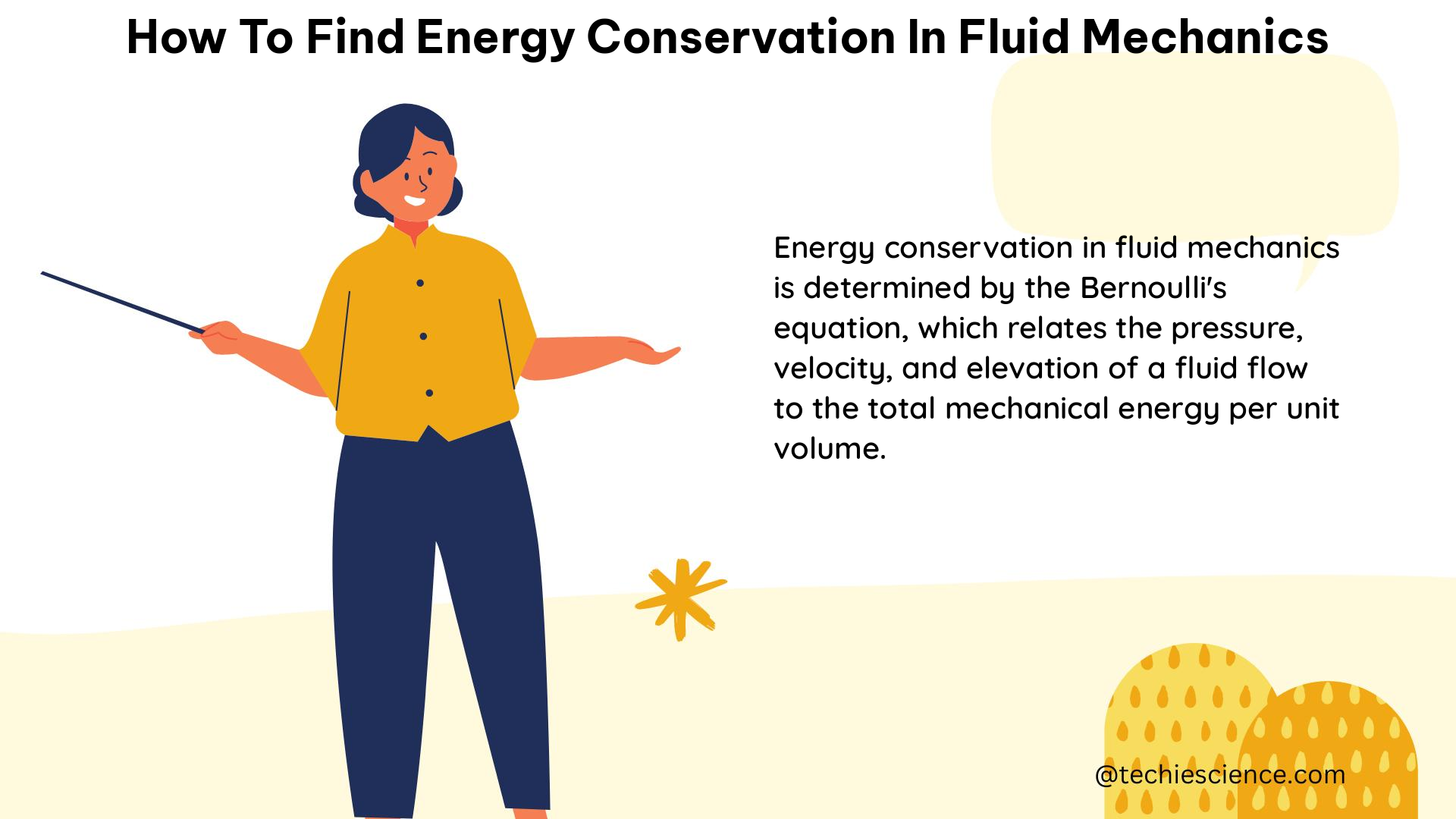In fluid mechanics, the conservation of energy is a fundamental principle that governs the transfer and transformation of energy within a fluid system. Understanding energy conservation is crucial for analyzing the behavior and performance of various fluid-based applications, such as hydraulic systems, aerodynamics, and heat transfer processes. This comprehensive guide will walk you through the step-by-step process of finding energy conservation in fluid mechanics, providing you with the necessary formulas, examples, and technical specifications to master this concept.
Conservation of Energy Equation
The conservation of energy equation is derived from the first law of thermodynamics and is used to analyze the transfer of energy in a fluid system. The total energy of a fluid system includes three main components: kinetic energy, potential energy, and internal energy.
The general form of the conservation of energy equation is:
$E = \frac{1}{2}mv^2 + mgh + U$
Where:
– $E$ is the total energy of the fluid system
– $\frac{1}{2}mv^2$ is the kinetic energy, where $m$ is the mass of the fluid and $v$ is its velocity
– $mgh$ is the potential energy, where $m$ is the mass, $g$ is the acceleration due to gravity, and $h$ is the height
– $U$ is the internal energy, which is typically a function of temperature and pressure
This equation represents the balance between the different forms of energy within the fluid system, and it is essential for understanding the energy transformations that occur in various fluid mechanics applications.
Bernoulli’s Equation

Bernoulli’s equation is a simplified form of the energy equation, applicable to incompressible, inviscid flows with no energy addition or removal. It relates the pressure, velocity, and height of a fluid at different points in a streamline.
The Bernoulli equation is expressed as:
$P_1 + \frac{1}{2}\rho v_1^2 + \rho gh_1 = P_2 + \frac{1}{2}\rho v_2^2 + \rho gh_2$
Where:
– $P_1$ and $P_2$ are the pressures at two points in the fluid
– $\rho$ is the density of the fluid
– $v_1$ and $v_2$ are the velocities at two points in the fluid
– $h_1$ and $h_2$ are the heights at two points in the fluid
Bernoulli’s equation is a powerful tool for analyzing the behavior of fluids in various applications, such as pipe flow, aerodynamics, and hydraulic systems.
Applications and Examples
Leaking Tank
The conservation of energy can be applied to a leaking tank, where the flow rates at the top and the leak are equal, and the pressure at the top is negligible. In this scenario, the total energy of the fluid system is conserved, and the energy equation can be used to determine the velocity of the fluid at the leak.
Pipe Flow
Bernoulli’s equation can be used to calculate the pressure drop or velocity change in a pipe due to changes in diameter or height. By applying the Bernoulli equation at different points along the pipe, you can analyze the energy transformations and predict the fluid behavior.
For example, consider a pipe with a sudden contraction in diameter. As the fluid flows through the contraction, the velocity increases, and the pressure decreases according to Bernoulli’s equation. This pressure drop can be used to determine the flow rate or the power required to maintain the desired flow.
Technical Specifications
Units
The units for energy in fluid mechanics are typically joules (J) or kilojoules per kilogram (kJ/kg). These units represent the amount of work or energy per unit of mass, which is a common way to express energy in fluid systems.
Assumptions
The Bernoulli equation assumes the following:
– Incompressible flow: The fluid density remains constant throughout the system.
– Inviscid flow: The effects of viscosity are negligible, and there is no energy dissipation due to friction.
– No energy addition or removal: There are no external sources or sinks of energy within the fluid system.
These assumptions simplify the analysis and allow for the application of Bernoulli’s equation, but they may not always hold true in real-world fluid mechanics problems. In such cases, the full conservation of energy equation may need to be considered.
Conclusion
Energy conservation is a fundamental principle in fluid mechanics that governs the transfer and transformation of energy within a fluid system. By understanding the conservation of energy equation and Bernoulli’s equation, you can analyze the behavior and performance of various fluid-based applications, such as hydraulic systems, aerodynamics, and heat transfer processes.
This guide has provided you with the necessary formulas, examples, and technical specifications to help you master the concept of energy conservation in fluid mechanics. Remember to always consider the underlying assumptions and limitations of the equations, and be prepared to apply the full conservation of energy equation when necessary.
References
- Çengel, Y. A., & Cimbala, J. M. (2018). Fluid Mechanics: Fundamentals and Applications (4th ed.). McGraw-Hill Education.
- Munson, B. R., Young, D. F., Okiishi, T. H., & Huebsch, W. W. (2013). Fundamentals of Fluid Mechanics (7th ed.). John Wiley & Sons.
- Pritchard, P. J., & Mitchell, J. W. (2016). Fox and McDonald’s Introduction to Fluid Mechanics (9th ed.). John Wiley & Sons.
- Streeter, V. L., & Wylie, E. B. (1985). Fluid Mechanics (8th ed.). McGraw-Hill.

The lambdageeks.com Core SME Team is a group of experienced subject matter experts from diverse scientific and technical fields including Physics, Chemistry, Technology,Electronics & Electrical Engineering, Automotive, Mechanical Engineering. Our team collaborates to create high-quality, well-researched articles on a wide range of science and technology topics for the lambdageeks.com website.
All Our Senior SME are having more than 7 Years of experience in the respective fields . They are either Working Industry Professionals or assocaited With different Universities. Refer Our Authors Page to get to know About our Core SMEs.